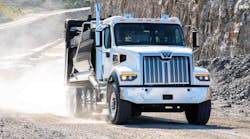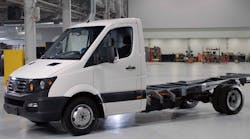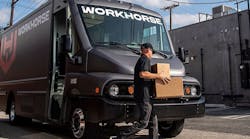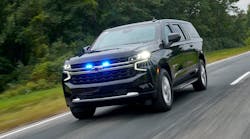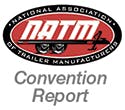General Motors is focusing a lot of attention right now on a continuous approach that addresses avoiding the crash.
“There is the traditional safety part with air bags and belts and body structure that we often associate with safety,” said John Capp, director of global vehicle safety for General Motors. “That’s during the crash. We’ve made huge strides in the industry over the years. And also in the after-the-crash too, when OnStar calls for help. And not only calls for help but it actually sends information that can be used to help determine what kind of a crash just took place. And the exact location, to help try to get the right emergency rescue personnel routed to that location.
In his presentation, “Trends in Vehicle Safety Technology,” Capp said the National Highway Traffic Safety Administration (NHTSA) believes that the increase in annual traffic deaths in the United States to 35,000 is partly due to an increase in driving due to an improved economy, but also to some bad behaviors.
GM launched its V2V technology in February, becoming the first company to do so in the US.
“It’s got a lot of potential to ultimately enhance other features and help safety,” Capp said. “It does that by vehicles literally talking to each other. If every vehicle can talk to each other—and while we’re at it, talk to the traffic light and pedestrian—eventually you can get to the point where everybody’s on the grid and can sense how far I’m away from you and how fast I’m going, and should be able to avoid most crashes. NHTSA did a study that said it can help 80% of all crashes, so the potential is huge.
“V2V uses a special modified version of WiFi and GPS on a dedicated 5.9GHz frequency to help reduce or mitigate crashes. I can see a car that might be around the corner. Maybe your view is blocked by a tree or billboard. Once vehicles are equipped, we can avoid a lot of crashes.
“It’s about safety. There’s mobility. You can time traffic lights and help pace each other. There’s sensing. You can’t see five cars ahead in traffic. But with this technology, you can send a message back, and now you can.”
Examples of safety applications:
• Emergency electronic brake lights (EEBL). “This is where you have a car that’s five vehicles ahead of you. They’re mashing on the brake because a kid’s ball went into the street. Instead of getting into a pileup like you do on freeways, you can send that signal back and people behind you know you’re applying your brakes in an emergency manner.”
• Left turn assist (LTA). “Those can be tricky with certain types of drivers and certain types of roads. They can be prone to a lot of crashes.”
• Intersection movement assist (IMA). “Those are easy to envision. How many times can you not see other vehicles coming toward an intersection? You don’t know if they’re going to stop.”
• Forward collision warning (FCW).
• Blind spot/lane-change warning (BSW/LCW).
• Do not pass warning (DNPW).
He said that over a decade of collaborative research between the industry and the government has now established the standards needed to support deployment.
“We worked with other OEMs a lot,” he said. “We’ve done a lot of research projects with the government and for the government to try to help establish standards to make this possible. What’s unique about technology like this is that if every car doesn’t send the same message to the same signals, it’s not going to work. The cameras and radar features you can buy from any supplier you want. This has to be the same everywhere. The only way this can happen is with government standards and regulation. As an industry that doesn’t like to be regulated, this is tech we’ve been supportive of. This 80% (reduction in crashes) is a big deal.”
In 1999, the Federal Communications Commission (FCC) dedicated 75 MHz of the spectrum at 5.9 GHz for intelligent transportation systems.
Characteristics are:
• Fast acquisition (no network). “Taking that spectrum and having radios talking to each other, if you’re going to do safety stuff, you have to have fast acquisition. You can’t be dialing a phone to get a connection. It needs to be on all the time.”
• Low latency. “If we’re going to be helping to prevent crashes, it needs to be in the order of milliseconds, not any longer than that.”
• High reliability and data transfer. “If you get 100 cars around some busy intersection, you need to have the bandwidth to be able to hand it.”
• 360-degree sensing. “It beacons out in all directions.”
“Not all technologies can do that,” he said. “Your cell phone can do some of these things, but it can’t do it that fast.”
The standards have just gone in place to make it happen: IEEE 802.11p, 1609.2-1609.4, 1609.12, and SAE J2735 and J2945.
And there is a V2V basic safety message at 109 Hz: random vehicle ID, sequence number; time stamp; position (latitude/longitude/elevation/accuracy); motion (speed, trans state, heading angle, brake, acceleration/deceleration); control (yaw rate); and vehicle size (length, width).
In December, NHTSA issued a Notice of Proposed Rulemaking that proposes a new FMVSS 150 standard, with a comment period that ended April 12. It will involve light-duty vehicles of less than 10,000 lbs GVWR only. System performance is driven by IEEE and SAE standards, and vehicles must send and receive Basic Safety Messages (BSM).
There is a proposed lead time two years after the final rule was issued. The ramp-up would start with 50% involvement in the first year (likely the 2022MY or later), with 75% in the second year, and 100% in the third year.
“It’s hard to predict what will happen,” he said. “We’re in the process of responding to it. We’re supportive of it and so are other OEMs. But we really don’t know whether they will be able to get to a final rule in two years. That’s actually fairly aggressive, given how complicated it is and the history for how long it takes to get rulemaking.
“More research is ongoing and needed. Trailering was not addressed by NHTSA at this time. The CAMP V2l consortium will do some research on applications for heavy-duty trucks. J1939 could be an enabler for truck and trailer communication.
“We’ll be into the mid-2020s until this technology becomes commonplace on vehicles.” ♦



